- 1Stanford Institute for Materials and Energy Sciences, SLAC National Accelerator Laboratory and Stanford University, Menlo Park, CA, United States
- 2Department of Materials Science and Engineering, Stanford University, Stanford, CA, United States
The quest to understand the nature of superconductivity in the cuprates has spotlighted the pair density wave (PDW)–a superconducting state characterized by a spatially modulated order parameter. Despite significant advances in understanding PDW properties, conclusively demonstrating its presence in systems pertinent to cuprate superconductors remains elusive. In this study, we present a systematic density-matrix renormalization group study to investigate the Emery model (or the three-band Hubbard model) on two-leg square cylinders with negative electron hopping term tpp between adjacent oxygen sites. Kinetic frustration - introduced by changing the sign of oxygen-oxygen hopping - leads to a much reduced Cu-Cu antiferromagnetic exchange along with an enlarged charge transfer energy that changes the local properties of the model. At light doping levels, our findings reveal a ground state remarkably consistent with a PDW, exhibiting mutually commensurate superconducting (SC), charge, and spin density wave correlations. Intriguingly, the dominant SC pairing is observed between neighboring oxygen sites, diverging from the expected Cu sites in the positive tpp case. When the system incorporates moderate near-neighbor interactions, particularly an attractive Vpp between adjacent oxygen sites, the SC correlations become quasi-long-ranged, accompanied by a pronounced divergence in the PDW susceptibility. When the attractive Vpp increases further, the system gives way to an unconventional d-wave superconductivity.
1 Introduction
The Emery model, also known as the three-band Hubbard model, has long been proposed as one of the minimal models to understand the electronic properties of cuprate high-temperature superconductors Zaanen et al. (1985); Emery (1987); Scalettar (1989); Scalettar et al. (1991); White and Scalapino (2015); Huang et al. (2017); Jiang et al. (2023). In this model, a square lattice of copper (Cu) and oxygen (O) atoms in the CuO2 plane (see Figure 1) is considered, where the Copper sites are represented by a single
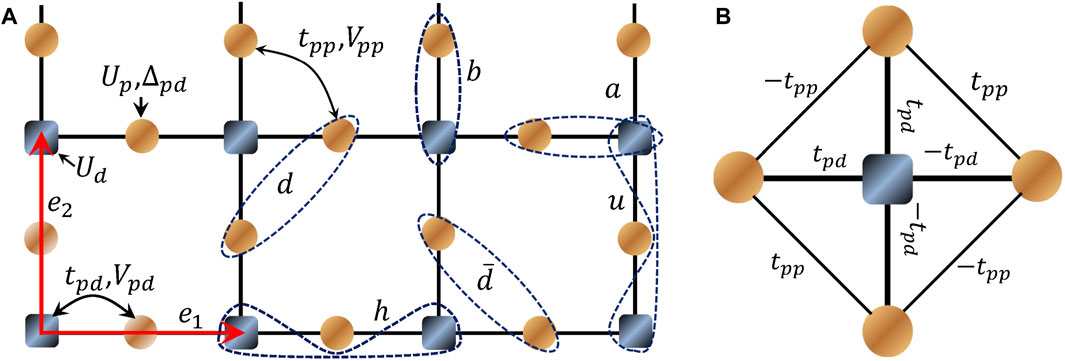
FIGURE 1. Emery model on the square lattice. (A) The squares represent Cu
Here
While the Emery model has been proposed as one of the critical frameworks for studying the cuprates superconductors, which captures phenomena like superconductivity, charge, and spin density wave orders Zaanen et al. (1985); Emery (1987); Scalettar (1989); White and Scalapino (2015); Huang et al. (2017); Jiang et al. (2023), it has more recently been extended to investigate the emergence of novel pair density wave (PDW) states Jiang (2023). In a PDW state, the superconducting (SC) order parameter carries finite center-of-mass momentum and varies spatially so that its spatial average vanishes Fulde and Ferrell (1964); Larkin and Ovchinnikov (1965); Berg et al. (2009); Fradkin et al. (2015); Agterberg et al. (2020); Lee (2014); Jian et al. (2020); Lozano et al. (2022). The PDW state has been considered a promising candidate state to understand the physics of cuprates high-temperature superconductors and other strongly correlated systems, where it has been proposed that various phases, including the superconductivity, charge, and spin density wave orders, can emerge by partially melting the PDW state Lee (2014); Fradkin et al. (2015); Agterberg et al. (2020); Himeda et al. (2002). Recently, intense interest in the PDW state has emerged due to experimental observations in cuprate superconductors Bi2Sr2CaCu2O8+x Hamidian et al. (2016); Ruan et al. (2018); Edkins et al. (2019); Liu et al. (2021) and La1.875Ba0.125CuO4 Agterberg and Tsunetsugu (2008); Li et al. (2007); Berg et al. (2007); Tranquada et al. (2008); Tranquada (2020), Tranquada (2021), kagome superconductor CsV3Sb5 Chen H. et al. (2021) and iron-based superconductor Liu et al. (2023).
The realization of a PDW state in microscopic lattice models remains highly nontrivial and usually involves modifying or extending existing frameworks like the Hubbard models to include competing interactions or inhomogeneities that can give rise to spatial modulations Berg et al. (2010); Jaefari and Fradkin (2012); Venderley and Kim (2019); Xu et al. (2019); Peng et al. (2021a,b); Han et al. (2020); Huang et al. (2022); Wu et al. (2023); Jiang and Yao (2023). These include the Kondo-Heisenberg model Berg et al. (2010), the extended Hubbard-Heisenberg model Jaefari and Fradkin (2012), the strong coupling limit of the Holstein-Hubbard model Han et al. (2020); Huang et al. (2022) and generalized t-J and Hubbard models Xu et al. (2019); Venderley and Kim (2019); Peng et al. (2021a), Peng et al. (2021b). More recently, it has also been shown by one of the authors that the PDW ground state can also be realized in the three-band Hubbard model on a two-leg square cylinder Jiang (2023), where the SC correlations are dominant between neighboring Cu sites with
2 Model Hamiltonian and method
In the present work, we consider the Emery model on the square lattice as defined in Figure 1 and Eq. 2 to study whether the same PDW state or distinct SC state emerges upon doping as well as the associated pairing symmetry using the density-matrix renormalization group (DMRG) White (1992), White (1993). The signs of the hopping matrix elements in the related orbital configuration, i.e., Cu
Following Ref. White and Scalapino (2015); Jiang (2023), we set tpd = 1 as the energy unit and take a canonical set of parameters Ud = 8, Up = 3, Δpd = 3 for cuprates White and Scalapino (2015); Armitage et al. (2010); Haule et al. (2014) but negative tpp = −0.5, and study the ground state properties of this system as a function of Vpd and Vpp. We focus on two-leg cylinders as shown in Figure 1 with width Ly = 2 and length up to Lx = 96, where Lx and Ly are the number of unit cells along the e1 and e2 directions, respectively. The total number of sites is N = 3LxLy + 2Ly = 3Nu + 2Ly, where Nu is the number of unit cells. The overall hole density of the system is defined as ρ = 1 + δ, where δ = Nh/Nu and Nh denote the hole doping concentration and number of doped holes away from half-filling, respectively. We consider δ = 1/12 and 1/8, and keep up to m = 20,000 states with a typical truncation error ϵ ∼ 10–10.
3 Results
3.1 Phase diagram
Our main results are summarized in the ground state phase diagram in Figure 2. When Vpp between oxygen sites are not strongly attractive, we find that the ground state of the system is consistent with that of a PDW state with power-law and mutually commensurate SC, charge-density wave (CDW), and spin-density-wave (SDW) correlations. The SC correlations oscillate periodically in real space in such a way that its spatial average vanishes and the PDW ordering wavevector Q ≈ 2πδ is incommensurate. Contrary to the positive tpp case White and Scalapino (2015); Jiang (2023), our results show that the SC pairing is dominant between adjacent oxygen sites instead of Cu sites. Accordingly, the SC pairing symmetry is consistent with dxy rather than
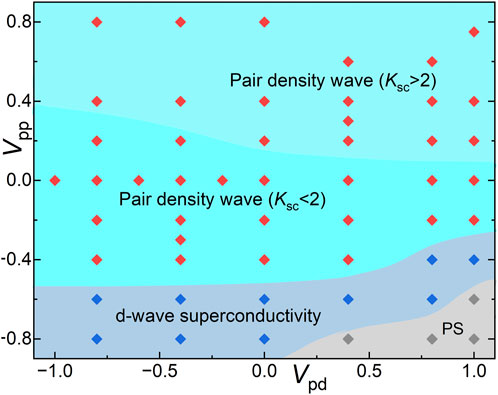
FIGURE 2. Ground state phase diagram of the Emery model on two-leg square cylinders at δ = 1/8. The solid symbols are numerical data points and PS denotes phase separation. The shaded regions are guides for eyes.
3.2 Pair density wave phase
As shown in Figure 2, the majority of the ground state phase diagram is occupied by the PDW phase, where the SC correlations decay as a power-law at long distances and oscillate periodically in real space in such a way that its spatial average vanishes. We provide detailed examples in Figure 3 and Figure 4 for several characteristic sets of parameters. Our conclusions hold for all parameters in the PDW phase in Figure 2.
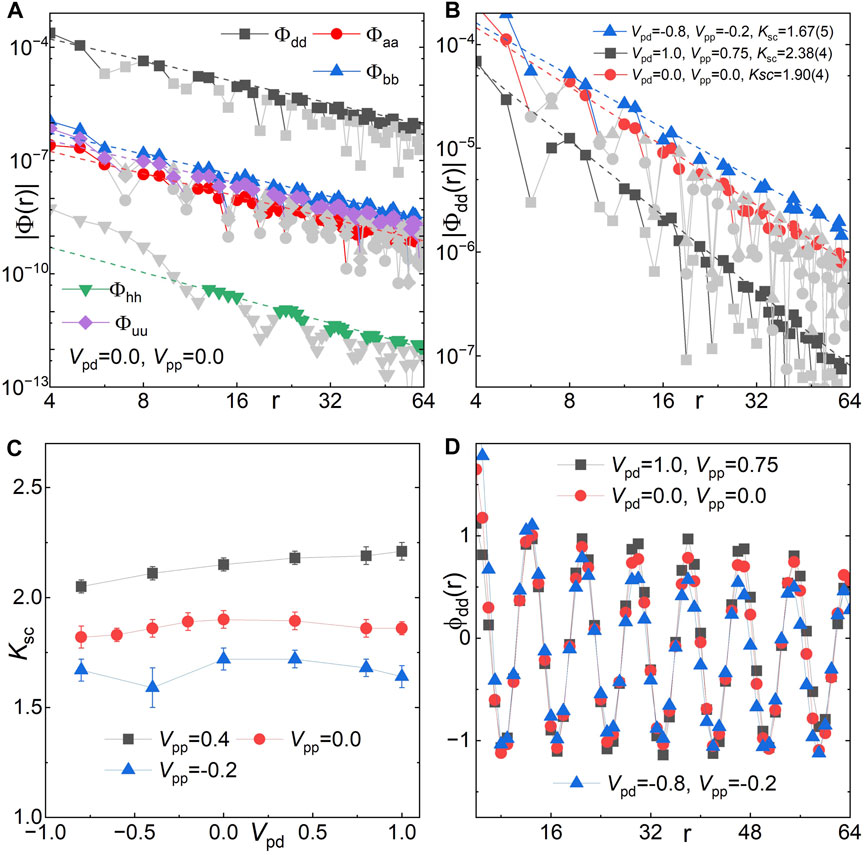
FIGURE 3. Superconducting correlations in the pair density wave phase at δ = 1/8. The magnitude of SC correlations are shown in (A) for Φ(r) at Vpd = Vpp = 0, and in (B) for Φdd(r) with different Vpd and Vpp. The dashed lines represent fits to a power-law function
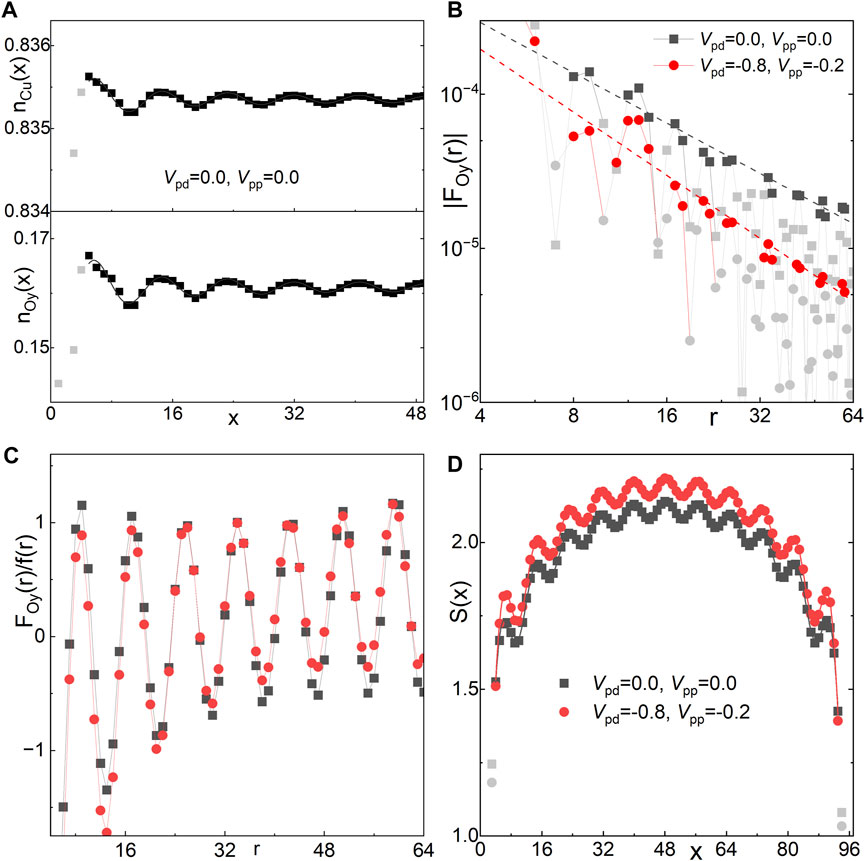
FIGURE 4. Charge density profile, spin-spin correlation and entanglement entropy in the pair density wave phase at δ = 1/8. (A) Charge density profiles nCu(x) on the Cu site and nOy(x) on the Oy site for Vpd = Vpp = 0. (B) The magnitude of the spin-spin correlation |F(r)| where the dashed lines represent power-law fits
3.2.1 Superconducting correlations
In order to explore the potential for superconductivity, we have calculated the equal-time spin-singlet SC pair-pair correlations defined as
Here,
We have closely examined the spatial distribution of SC correlations, specifically targeting Φdd(r). Our findings, based on three representative parameter choices, are depicted in Figure 3D. Here, Φdd(r) exhibits clear spatial oscillations as Φdd(r) ∼ f(r)ϕdd(r) over a vast region of r. In this context, f(r) acts as the envelope, while ϕdd(r) gives rise to the spatial oscillation. As we move to longer distances, the envelope function f(r) adheres to a power-law decay
The spatial oscillation of the SC correlations Φ(r) is captured by the normalized function ϕ(r), as previously defined. Depictions of ϕdd(r) are presented in Figure 3D and align well with the fitting function ϕdd(r) ∼ sin(Qr + θ). This pattern resonates with characteristics observed in the PDW state with a vanishing spatial average of ϕ(r) Agterberg et al. (2020). The PDW ordering wavevector appears to be incommensurate as Q ≈ 2πδ with a corresponding wavelength λsc ≈ 1/δ. For instance, λsc ≈ 8 for δ = 1/8 as evidenced in Figure 3D, whereas λsc ≈ 12 for δ = 1/12.
3.2.2 Charge density wave
We have calculated the charge density profile
At long distance, the spatial decay of the CDW correlation is dominated by a power-law with an exponent Kc, which can be obtained by fitting the charge density oscillations induced by the cylinder boundaries White et al. (2002).
Here AQ and A2Q are amplitudes, ϕ1 and ϕ2 are phase shifts and n0 is the mean density. Examples of the extracted exponents for δ = 1/8 are Kc(Cu)
3.2.3 Spin-spin correlations
To elucidate the magnetic properties of the ground state, we examine the spin-spin correlation functions
3.2.4 Entanglement entropy
Our findings indicate the presence of multiple gapless modes, encompassing both charge and spin degrees of freedom. These can be characterized by the central charge, c. This charge is derivable from the von Neumann entropy, formulated as: S(x) = −Trρxlnρx where ρx represents the reduced density matrix for a subsystem of length x. For critical systems in 1 + 1 dimensions, described through a conformal field theory, it has been established Calabrese and Cardy (2004); Fagotti and Calabrese (2011) that for an open system of length Lx,
where
3.3 d-wave superconductivity
When further increasing the attractive Vpp, the system evolves into a d-wave SC phase. Similar to the PDW phase, we find that Φdd(r) in Figure 5A and
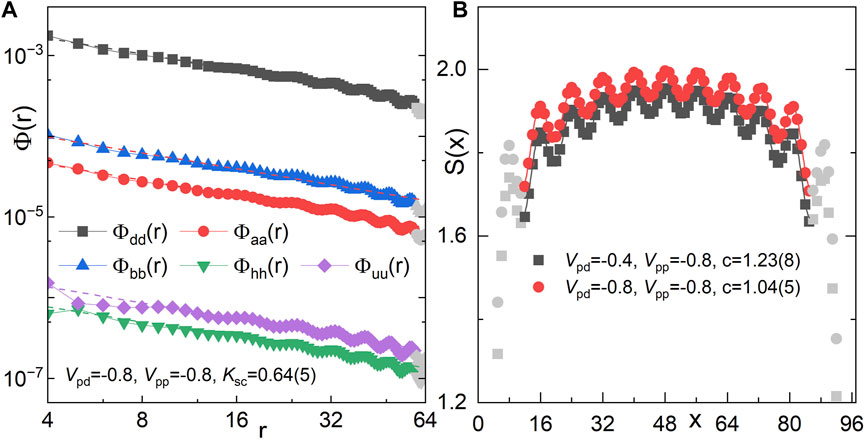
FIGURE 5. Superconducting correlations and entanglement entropy in the d-wave SC phase at δ = 1/8. (A) SC correlations for Vpd = −0.8 and Vpp = −0.8. Dashed lines represent fits to a power-law function
While there are similarities, several significant distinctions can be drawn between the PDW phase and the d-wave SC phase: (1) in the d-wave SC phase, the SC correlations Φαβ(r) maintain a consistent sign in real space, as depicted in Figure 5A, and the SC order parameter does not possess finite momentum, (2) the spin-spin correlation functions in this phase are short-ranged and undergo exponential decay, (3) a singular gapless mode with c ≈ 1 is evident, as illustrated in Figure 5B. For instance, the extracted central charge c ≈ 1.04 for Vpd = −0.8 and Vpp = −0.8, and c ≈ 1.2 for Vpd = −0.8 and Vpp = −0.4. Given these observations, our results affirm that the ground state of the d-wave SC phase aligns with the characteristics of a Luther-Emery liquid Emery (1987). This is reminiscent of the single-band Hubbard model on four-leg square cylinders as discussed in prior studies Jiang et al. (2018); Jiang and Devereaux (2019); Jiang Y.-F. et al. (2020); Chung et al. (2020); Jiang H.-C. et al. (2020); Gong et al. (2021); Peng et al. (2023).
4 Summary and discussion
In conclusion, we have extensively investigated the ground state properties of the lightly doped three-band Hubbard model on two-leg square cylinders, specifically focusing on near-neighbor Cu-O and O-O interactions. Our results strongly suggest that the system’s ground state is aligned with the characteristics of a PDW state, showcasing quasi-long-range PDW order and pronounced susceptibility. Several aspects of our findings are unexpected. Within the doped negative tpp Emery model, Cooper pairing prominently emerges between adjacent oxygen sites rather than between neighboring Cu sites. This stands in stark contrast to the prevailing understanding, where Cooper pairing is believed to be dominant between neighboring Cu sites. It has been postulated that cuprate physics can be encapsulated by a single-band effective Hamiltonian, exclusively encompassing the Cu d holes Zhang and Rice (1988). While the pairing symmetry aligns with the d-wave symmetry, it manifests as dxy rather than
To understand these results, we return to cluster calculations that determine the relevant parameters t and J of an effective single band model Eskes et al. (1989), Eskes et al. (1990). Specifically, we consider Cu2O7 clusters with the same parameters used for DMRG, and compare the results for positive and negative tpp. Our results are summarized in Table 1. Determining the singlet-triplet energy difference for two holes on the cluster yields an exchange energy J = 0.0179 for tpp = −0.5, compared to 0.165 if the sign of tpp is reversed. Largely interpreted as due to an increase in the effective charge transfer energy when ligand delocalization is considered, the effective spin exchange between Cu spins is greatly reduced for negative tpp. While the dependence on Vpp is negligible, a negative Vpd increases the magnetic exchange for the two-hole ground state configuration. The increase of J for negative Vpd may help to favor stronger hole singlet bonding, promoting stronger SC susceptibilities in Figure 3.

TABLE 1. Effective single band exchange parameter J and NN hopping t determined from Cu2O7 clusters for different values of tpp as indicated. All other parameters are the same as used in the main text.
Calculations for three holes on the same cluster yield the hopping parameter t, defined as the energy difference between the ground and first excited state. For Vpp = Vpd = 0, 2t = −0.673 for tpp = 0.5 while 2t = −8 × 10−4 for tpp = −0.5. These numbers increase slightly for Vpp < 0, but overall a reversed sign of tpp dramatically affects the magnitude of the NN hopping.
Lastly, the binding of the holes can be examined for the ground state of four holes on the same cluster (see Figure 6). For both tpp positive and negative, the ground state is a spin-singlet, with Cu spins and O spins both forming singlets. However, the spatial orientation of bound holes on O is different: for tpp = 0.5, O holes primarily bind to Cu at the ends of the cluster, without substantial hole occupation on the central, bridging oxygen, while for tpp = −0.5, O holes primarily bind to the central oxygen in a local dxy configuration with neighboring oxygens. As this might be expected when antiferromagnetic exchange among oxygen becomes dominant over Cu, the predominance of dxy pairing observed in the phase diagram of Figure 2 may be related to this tendency to bind neighboring O holes.

FIGURE 6. Predominant hole distributions for tpp positive or negative, as indicated. Solid red spheres denote approximately a full hole charge, while shaded red spheres denote an approximate quarter charge.
Data availability statement
The raw data supporting the conclusion of this article will be made available by the authors, without undue reservation.
Author contributions
H-CJ: Writing–original draft, Writing–review and editing. TD: Writing–original draft, Writing–review and editing.
Funding
The author(s) declare financial support was received for the research, authorship, and/or publication of this article. This work was supported by the Department of Energy, Office of Science, Basic Energy Sciences, Materials Sciences, and Engineering Division, under Contract DE-AC02-76SF00515.
Acknowledgments
We are grateful to Steven Kivelson for insightful discussions and invaluable suggestions.
Conflict of interest
The authors declare that the research was conducted in the absence of any commercial or financial relationships that could be construed as a potential conflict of interest.
The author(s) declared that they were an editorial board member of Frontiers, at the time of submission. This had no impact on the peer review process and the final decision.
Publisher’s note
All claims expressed in this article are solely those of the authors and do not necessarily represent those of their affiliated organizations, or those of the publisher, the editors and the reviewers. Any product that may be evaluated in this article, or claim that may be made by its manufacturer, is not guaranteed or endorsed by the publisher.
References
Agterberg, D. F., Davis, J. S., Edkins, S. D., Fradkin, E., Van Harlingen, D. J., Kivelson, S. A., et al. (2020). The physics of pair-density waves: cuprate superconductors and beyond. Annu. Rev. Condens. Matter Phys. 11, 231–270. doi:10.1146/annurev-conmatphys-031119-050711
Agterberg, D. F., and Tsunetsugu, H. (2008). Dislocations and vortices in pair-density-wave superconductors. Nat. Phys. 639, 639–642. doi:10.1038/nphys999
Armitage, N. P., Fournier, P., and Greene, R. L. (2010). Progress and perspectives on electron-doped cuprates. Rev. Mod. Phys. 82, 2421–2487. doi:10.1103/RevModPhys.82.2421
Berg, E., Fradkin, E., Kim, E.-A., Kivelson, S. A., Oganesyan, V., Tranquada, J. M., et al. (2007). Dynamical layer decoupling in a stripe-ordered high-Tc superconductor. Phys. Rev. Lett. 99, 127003. doi:10.1103/PhysRevLett.99.127003
Berg, E., Fradkin, E., and Kivelson, S. A. (2010). Pair-density-wave correlations in the kondo-heisenberg model. Phys. Rev. Lett. 105, 146403. doi:10.1103/PhysRevLett.105.146403
Berg, E., Fradkin, E., Kivelson, S. A., and Tranquada, J. M. (2009). Striped superconductors: how spin, charge and superconducting orders intertwine in the cuprates. New J. Phys. 11, 115004. doi:10.1088/1367-2630/11/11/115004
Calabrese, P., and Cardy, J. (2004). Entanglement entropy and quantum field theory. J. Stat. Mech. Theory Exp. 2004, P06002, doi:10.1088/1742-5468/2004/06/p06002
Chen, H., Yang, H., Hu, B., Zhao, Z., Yuan, J., Xing, Y., et al. (2021a). Roton pair density wave in a strong-coupling kagome superconductor. Nature 599, 222–228. doi:10.1038/s41586-021-03983-5
Chen, Z., Wang, Y., Rebec, S. N., Jia, T., Hashimoto, M., Lu, D., et al. (2021b). Anomalously strong near-neighbor attraction in doped 1D cuprate chains. Science 373, 1235–1239. doi:10.1126/science.abf5174
Chung, C.-M., Qin, M., Zhang, S., Schollwöck, U., and White, S. R. (2020). Plaquette versus ordinary d-wave pairing in the t′-hubbard model on a width-4 cylinder. Phys. Rev. B 102, 041106. doi:10.1103/PhysRevB.102.041106
Edkins, S. D., Kostin, A., Fujita, K., Mackenzie, A. P., Eisaki, H., Uchida, S., et al. (2019). Magnetic field–induced pair density wave state in the cuprate vortex halo. Science 364, 976–980. doi:10.1126/science.aat1773
Emery, V. J. (1987). Theory of high-tc superconductivity in oxides. Phys. Rev. Lett. 58, 2794–2797. doi:10.1103/PhysRevLett.58.2794
Eskes, H., Sawatzky, G., and Feiner, L. (1989). Effective transfer for singlets formed by hole doping in the high-tc superconductors. Phys. C. Supercond. 160, 424–430. doi:10.1016/0921-4534(89)90415-2
Eskes, H., Tjeng, L. H., and Sawatzky, G. A. (1990). Cluster-model calculation of the electronic structure of cuo: a model material for the high-Tc superconductors. Phys. Rev. B 41, 288–299. doi:10.1103/PhysRevB.41.288
Fagotti, M., and Calabrese, P. (2011). Universal parity effects in the entanglement entropy of XX chains with open boundary conditions. J. Stat. Mech. Theory Exp. 2011, P01017, doi:10.1088/1742-5468/2011/01/p01017
Fradkin, E., Kivelson, S. A., and Tranquada, J. M. (2015). Colloquium: theory of intertwined orders in high temperature superconductors. Rev. Mod. Phys. 87, 457–482. doi:10.1103/RevModPhys.87.457
Fulde, P., and Ferrell, R. A. (1964). Superconductivity in a strong spin-exchange field. Phys. Rev. 135, A550–A563. doi:10.1103/PhysRev.135.A550
Gong, S., Zhu, W., and Sheng, D. N. (2021). Robust d-wave superconductivity in the square-lattice t − J model. Phys. Rev. Lett. 127, 097003. doi:10.1103/PhysRevLett.127.097003
Hamidian, M. H., Edkins, S. D., Joo, S. H., Kostin, A., Eisaki, H., Uchida, S., et al. (2016). Detection of a cooper-pair density wave in Bi2Sr2CaCu2O8+x. Nature 532, 343–347. doi:10.1038/nature17411
Han, Z., Kivelson, S. A., and Yao, H. (2020). Strong coupling limit of the holstein-hubbard model. Phys. Rev. Lett. 125, 167001. doi:10.1103/PhysRevLett.125.167001
Haule, K., Birol, T., and Kotliar, G. (2014). Covalency in transition-metal oxides within all-electron dynamical mean-field theory. Phys. Rev. B 90, 075136. doi:10.1103/PhysRevB.90.075136
Himeda, A., Kato, T., and Ogata, M. (2002). Stripe states with spatially oscillating d-wave superconductivity in the two-dimensional t − t′ − J model. Phys. Rev. Lett. 88, 117001. doi:10.1103/PhysRevLett.88.117001
Huang, E. W., Mendl, C. B., Liu, S., Johnston, S., Jiang, H.-C., Moritz, B., et al. (2017). Numerical evidence of fluctuating stripes in the normal state of high-tc cuprate superconductors. Science 358, 1161–1164. doi:10.1126/science.aak9546
Huang, K. S., Han, Z., Kivelson, S. A., and Yao, H. (2022). Pair-density-wave in the strong coupling limit of the holstein-hubbard model. npj Quantum Mater 7, 17. doi:10.1038/s41535-022-00426-w
Jaefari, A., and Fradkin, E. (2012). Pair-density-wave superconducting order in two-leg ladders. Phys. Rev. B 85, 035104. doi:10.1103/PhysRevB.85.035104
Jian, S.-K., Scherer, M. M., and Yao, H. (2020). Mass hierarchy in collective modes of pair-density-wave superconductors. Phys. Rev. Res. 2, 013034. doi:10.1103/PhysRevResearch.2.013034
Jiang, H.-C. (2023). Pair density wave in the doped three-band hubbard model on two-leg square cylinders. Phys. Rev. B 107, 214504. doi:10.1103/PhysRevB.107.214504
Jiang, H.-C., Chen, S., and Weng, Z.-Y. (2020a). Critical role of the sign structure in the doped mott insulator: Luther-emery versus fermi-liquid-like state in quasi-one-dimensional ladders. Phys. Rev. B 102, 104512. doi:10.1103/PhysRevB.102.104512
Jiang, H.-C., and Devereaux, T. P. (2019). Superconductivity in the doped hubbard model and its interplay with next-nearest hopping t. Science 365, 1424–1428. doi:10.1126/science.aal5304
Jiang, H.-C., Weng, Z.-Y., and Kivelson, S. A. (2018). Superconductivity in the doped t-J model: results for four-leg cylinders. Phys. Rev. B 98, 140505. doi:10.1103/PhysRevB.98.140505
Jiang, S., Scalapino, D. J., and White, S. R. (2023). Density-matrix-renormalization-group-based downfolding of the three-band hubbard model: the importance of density-assisted hopping. arXiv.
Jiang, Y.-F., and Yao, H. (2023). Pair density wave superconductivity: a microscopic model in two dimensions. arXiv.
Jiang, Y.-F., Zaanen, J., Devereaux, T. P., and Jiang, H.-C. (2020b). Ground state phase diagram of the doped hubbard model on the four-leg cylinder. Phys. Rev. Res. 2, 033073. doi:10.1103/PhysRevResearch.2.033073
Kühner, T. D., White, S. R., and Monien, H. (2000). One-dimensional bose-hubbard model with nearest-neighbor interaction. Phys. Rev. B 61, 12474–12489. doi:10.1103/PhysRevB.61.12474
Larkin, A. I., and Ovchinnikov, Y. N. (1965). Nonuniform state of superconductors. Sov. Phys. JETP 20, 762–770.
Lee, P. A. (2014). Amperean pairing and the pseudogap phase of cuprate superconductors. Phys. Rev. X 4, 031017. doi:10.1103/PhysRevX.4.031017
Lee, P. A., Nagaosa, N., and Wen, X.-G. (2006). Doping a mott insulator: physics of high-temperature superconductivity. Rev. Mod. Phys. 78, 17–85. doi:10.1103/RevModPhys.78.17
Li, Q., Hücker, M., Gu, G. D., Tsvelik, A. M., and Tranquada, J. M. (2007). Two-dimensional superconducting fluctuations in stripe-ordered la1.875 ba0.125cuo4. Phys. Rev. Lett. 99, 067001. doi:10.1103/PhysRevLett.99.067001
Liu, X., Chong, Y. X., Sharma, R., and Davis, J. C. S. (2021). Discovery of a cooper-pair density wave state in a transition-metal dichalcogenide. Science 372, 1447–1452. doi:10.1126/science.abd4607
Liu, Y., Wei, T., He, G., Zhang, Y., Wang, Z., and Wang, J. (2023). Discovery of a pair density wave state in a monolayer high-Tc iron-based superconductor. Nature 618, 934–939. doi:10.1038/s41586-023-06072-x
Lozano, P. M., Ren, T., Gu, G. D., Tsvelik, A. M., Tranquada, J. M., and Li, Q. (2022). Testing for pair density wave order in la1.875ba0.125cuo4. Phys. Rev. B 106, 174510. doi:10.1103/PhysRevB.106.174510
Peng, C., Jiang, Y.-F., Devereaux, T. P., and Jiang, H.-C. (2021a). Precursor of pair-density wave in doping kitaev spin liquid on the honeycomb lattice. npj Quantum Mater 6, 64. doi:10.1038/s41535-021-00363-0
Peng, C., Jiang, Y.-F., Wang, Y., and Jiang, H.-C. (2021b). Gapless spin liquid and pair density wave of the hubbard model on three-leg triangular cylinders. New J. Phys. 23, 123004. doi:10.1088/1367-2630/ac3a83
Peng, C., Wang, Y., Wen, J., Lee, Y. S., Devereaux, T. P., and Jiang, H.-C. (2023). Enhanced superconductivity by near-neighbor attraction in the doped extended hubbard model. Phys. Rev. B 107, L201102. doi:10.1103/PhysRevB.107.L201102
Qu, D.-W., Chen, B.-B., Jiang, H.-C., Wang, Y., and Li, W. (2022). Spin-triplet pairing induced by near-neighbor attraction in the extended hubbard model for cuprate chain. Commun. Phys. 5, 257. doi:10.1038/s42005-022-01030-x
Ruan, W., Li, X., Hu, C., Hao, Z., Li, H., Cai, P., et al. (2018). Visualization of the periodic modulation of cooper pairing in a cuprate superconductor. Nat. Phys. 1178, 1178–1182. doi:10.1038/s41567-018-0276-8
Scalettar, R. (1989). Magnetic and pairing correlations in a three band hubbard model. Phys. C Supercond. its Appl. 162-164, 313–318. doi:10.1016/0921-4534(89)91033-2
Scalettar, R. T., Scalapino, D. J., Sugar, R. L., and White, S. R. (1991). Antiferromagnetic, charge-transfer, and pairing correlations in the three-band hubbard model. Phys. Rev. B 44, 770–781. doi:10.1103/PhysRevB.44.770
Tranquada, J. M. (2020). Cuprate superconductors as viewed through a striped lens. Adv. Phys. 69, 437–509. doi:10.1080/00018732.2021.1935698
Tranquada, J. M. (2021). Topological doping and superconductivity in cuprates: an experimental perspective. Symmetry 13, 2365. doi:10.3390/sym13122365
Tranquada, J. M., Gu, G. D., Hücker, M., Jie, Q., Kang, H.-J., Klingeler, R., et al. (2008). Evidence for unusual superconducting correlations coexisting with stripe order in la1.875ba0.125cuo4. Phys. Rev. B 78, 174529. doi:10.1103/PhysRevB.78.174529
Venderley, J., and Kim, E.-A. (2019). Evidence of pair-density wave in spin-valley locked systems. Sci. Adv. 5, eaat4698. doi:10.1126/sciadv.aat4698
White, S. R. (1992). Density matrix formulation for quantum renormalization groups. Phys. Rev. Lett. 69, 2863–2866. doi:10.1103/physrevlett.69.2863
White, S. R. (1993). Density-matrix algorithms for quantum renormalization groups. Phys. Rev. B 48, 10345–10356. doi:10.1103/PhysRevB.48.10345
White, S. R., Affleck, I., and Scalapino, D. J. (2002). Friedel oscillations and charge density waves in chains and ladders. Phys. Rev. B 65, 165122. doi:10.1103/PhysRevB.65.165122
White, S. R., and Scalapino, D. J. (2015). Doping asymmetry and striping in a three-orbital cuo2 hubbard model. Phys. Rev. B 92, 205112. doi:10.1103/PhysRevB.92.205112
Wu, Y.-M., Nosov, P. A., Patel, A. A., and Raghu, S. (2023). Pair density wave order from electron repulsion. Phys. Rev. Lett. 130, 026001. doi:10.1103/PhysRevLett.130.026001
Xu, X. Y., Law, K. T., and Lee, P. A. (2019). Pair density wave in the doped t − j model with ring exchange on a triangular lattice. Phys. Rev. Lett. 122, 167001. doi:10.1103/PhysRevLett.122.167001
Zaanen, J., Sawatzky, G. A., and Allen, J. W. (1985). Band gaps and electronic structure of transition-metal compounds. Phys. Rev. Lett. 55, 418–421. doi:10.1103/PhysRevLett.55.418
Keywords: pair density wave, superconductivity, Emery model, Hubbard model, density-matrix renormalization group
Citation: Jiang H-C and Devereaux TP (2023) Pair density wave and superconductivity in a kinetically frustrated doped Emery model on a square lattice. Front. Electron. Mater. 3:1323404. doi: 10.3389/femat.2023.1323404
Received: 17 October 2023; Accepted: 14 November 2023;
Published: 28 November 2023.
Edited by:
Ctirad Uher, University of Michigan, United StatesReviewed by:
Eduardo Fradkin, University of Illinois at Urbana-Champaign, United StatesJan Zaanen, Leiden University, Netherlands
John Tranquada, Brookhaven National Laboratory (DOE), United States
Copyright © 2023 Jiang and Devereaux. This is an open-access article distributed under the terms of the Creative Commons Attribution License (CC BY). The use, distribution or reproduction in other forums is permitted, provided the original author(s) and the copyright owner(s) are credited and that the original publication in this journal is cited, in accordance with accepted academic practice. No use, distribution or reproduction is permitted which does not comply with these terms.
*Correspondence: Hong-Chen Jiang, aGNqaWFuZ0BzdGFuZm9yZC5lZHU=; Thomas Peter Devereaux, dHBkQHN0YW5mb3JkLmVkdQ==
 Hong-Chen Jiang
Hong-Chen Jiang Thomas Peter Devereaux
Thomas Peter Devereaux